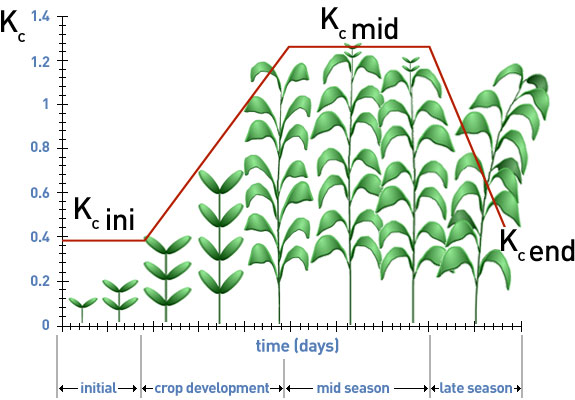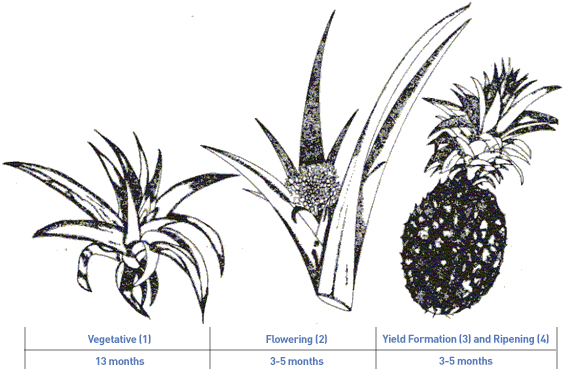- Pineapple (Ananas comosus) is a perennial crop grown for its fruits and used as a fresh and processed product.
- World production is about 13.7 million tons fresh fruit.(FAOSTAT, 2001).
- The origin of the pineapple is still uncertain but the Parana-Paraguay Basin has been considered as a possible area.
- For good growth pineapple requires mean daily temperatures of 22 to 26°C with an optimum of 23 to 24°C.
- Mean daily maximum and minimum temperatures of 30 and 20°C respectively for the whole growing period are considered optimum.
- Temperatures below or above this range affect fruit quality or the acid and sugar content.
- The crop is grown between 31°N and 34°S, primarily in regions with high relative humidity.
- A combination of optimum temperature and high humidity results in soft, large leaves and juicy fruits, low in acid content.
- Fruits ripening in periods with cool temperatures and low radiation levels, e.g. in winter or at high altitudes, are of inferior quality because of poor shape for canning.
- Requirements for canning are: a cylindrical shape, fruit eyes of a relatively shallow surface and a small fruit core in relation to the fruit.
- Pineapple can grow on a wide range of soils but a sandy loam texture is preferred.
- Optimum soil pH is 4.5 to 6.5.
- The soil should have a low lime content.
- The crop is sensitive to waterlogging and therefore requires a well-drained soil with good aeration.
- For high production the fertilizer needs are 230 to 300 kg/ha N, 45 to 65 kg/ha P and 110 to 220 kg/ha K.
- Pineapple is usually grown in double rows on raised beds.
- With a spacing of 0.6 x 0.3m in beds 0.75 to 0.90m apart, plant population is about 50000 per ha.
- Shading is sometimes used where temperatures are high and radiation intense to protect the crop from scorching.
- The crop is multiplied using slips, crowns and shoots or suckers, but in comparison with using suckers as planting material, the period from planting to harvest is about 20 percent longer when slips are used, and about 35 percent longer when crowns are used.
- Use of different planting material allows a manipulation of the crop growing period and particularly in selection of the time of harvest when climatic conditions are favorable for high quality fruits.
- Normally the plant crop is followed by one ratoon crop, but when climatic conditions are favorable, the crop will continue to bear fruits but quality rapidly declines after the first ratoon.
- However, in warm tropical climates, e.g. at low altitudes near the equator, no ratoon crop is possible because suckers do not develop.
- The period from planting to harvest of the plant crop is 1 to 2 years and of the ratoon crop 9 months to 1.5 years depending on planting material and climate.
- The flower initiation in pineapple is induced by low temperature, water deficit or hormone spray; the latter results in a uniform fruiting and harvest period.
Plant crop, first ratoon and second ratoon (Collins, 1960)
| | Stages of
Development | Plant
date | Region |
|---|
Crop
characteristic | Initial | Crop
Development | Mid-season | Late | Total | | |
Stage length,
days | 60 | 120 | 600 | 30 | 790 | February | Hawaii, USA |
Depletion Coefficient, p: | 0.4 | >> | 0.4 | 0.4 | – | | |
Root Depth, m | – | – | – | 0.5 | – | | |
Crop Coefficient,Kc1:
with bare soil
with grass cover | 0.5
0.5 | >>
>> | 0.3
0.5 | 0.3
0.5 | –
– | | |
Yield Response Factor, Ky | – | – | – | – | – | | |
1 The pineapple plant has very low transpiration because it closes its stomates during the day and opens them during the night. Therefore, the majority of ETc from pineapple is evaporation from the soil. The Kc mid < Kc ini since Kc mid occurs during full ground cover so that soil evaporation is less. Values given assume that 50 % of the ground surface is covered by black plasic mulch and that irrigation is by sprinkler. For drip irrigation beneath rhe plastic mulch Kc’s given can be reduced by 0.10.


